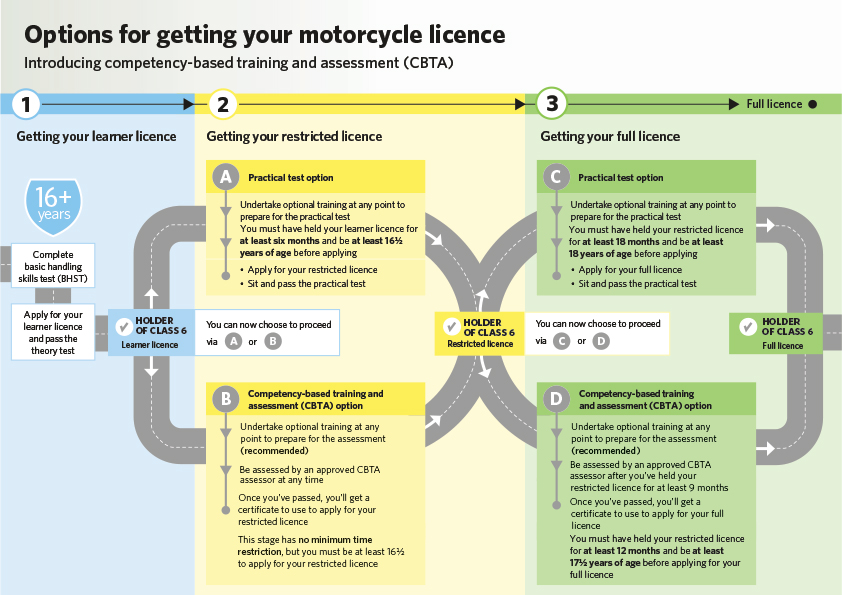Competency-based training and assessment (CBTA) gives you options when choosing how to get your motorcycle licence.
This option can reduce the amount of time it takes you to get your restricted or full licence, while ensuring you have the skills and knowledge you need to ride safely on New Zealand roads.
You can choose between the driver licence testing regime and the CBTA courses, or a combination of the two, to gain your restricted and/or full motorcycle licence.
This section is a reproduction of the CBTA course guide.
CBTA course guide
CBTA is a training and assessment option for people getting their motorcycle licence. Instead of taking a practical test at each stage of your licence you can choose to have your riding skills assessed by an approved CBTA assessor.
Although training isn’t compulsory, we recommend you complete training before attempting the assessment ride. This will ensure that you have the necessary riding skills and you’re fully prepared to do the assessment.
The assessments are designed to ensure you’re competent in a prescribed range of riding skills, which are important to keep you safe when riding our roads.
If you choose the CBTA option, there are a number of benefits:
You can choose the style of training suited to your needs. You can complete your training with one of the approved CBTA assessors or any other qualified motorcycle riding instructor.
CBTA courses utilise the knowledge of industry based assessors who have been approved to train and assess motorcyclists’ riding skills.
List of approved CBTA assessors and their contact details
In March 2014 Waka Kotahi NZ Transport Agency introduced CBTA to improve safety for motorcyclists.
The New Zealand Government’s Safer Journeys strategy identifies motorcycling safety as a priority area for improvement. In 2010, the government announced a package of reforms to improve the safety of motorcyclists through improved rider training and licensing requirements. Part of that package was the introduction of CBTA.
The more training and practical riding experience a motorcyclist gets, the more prepared they’re likely to be for potentially unsafe or confronting riding scenarios.
CBTA focuses on the specific skill sets required to help keep motorcyclists safe through the application of a robust course assessment and the availability of appropriate targeted training, resulting in improved riding skills and safer journeys for everyone on New Zealand roads.
There are two separate CBTA courses:
If you successfully complete a CBTA course in either stage, you’ll get a certificate to use to apply for the next stage of your driver licence. This means you won’t need to sit a practical test to get that licence. It can also reduce the time it takes you to gain your restricted or full motorcycle licence.
There are requirements you must meet before you can complete a CBTA course, and before you can get your restricted and full motorcycle licence.
Before you can undertake the learner stage, you’ll need to complete a basic handling skills test, sit the learner licence theory test, and obtain your learner motorcycle licence (Class 6L). You must be 16 years old before you can do this.
After you’ve completed the learner stage CBTA course, you must be at least 16½ years old before you can apply for your restricted driver licence.
You must have held your restricted (6R) driver licence for at least 9 months before you can complete the restricted stage course.
After you’ve completed the restricted stage CBTA course, you must have held your restricted driver licence for at least 12 months and be at least 17½ years old before you can apply for your full driver licence.
When progressing from your learner to restricted and restricted to full licences you can choose to progress either through both CBTA stages, through the regular testing regime, or a mixture of the two.
The following diagram shows how progression through the CBTA courses affects the learner and restricted stages of your licence.
